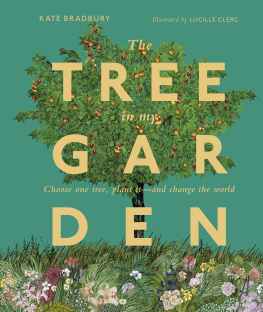THE
LITTLE
BOOK OF
PLANTING
TREES
MAX ADAMS is a critically acclaimed biographer and archaeologist and the author of eight books, including the best-selling The King in the North and The Wisdom of Trees . A teacher of woodland and tree histories, he manages an area of woodland in County Durham.
The King in the North
In the Land of Giants
The Wisdom of Trees
lfred's Britain
Unquiet Women
THE
LITTLE
BOOK OF
PLANTING
TREES
MAX ADAMS
AN ANIMA BOOK
www.headofzeus.com
This Anima book was first published in the UK in 2019 by Head of Zeus Ltd
Copyright Max Adams, 2019
The moral right of Max Adams to be identified as the author of this work has been asserted in accordance with the Copyright, Designs and Patents Act of 1988.
All rights reserved. No part of this publication may be reproduced, stored in a retrieval system, or transmitted in any form or by any means, electronic, mechanical, photocopying, recording, or otherwise, without the prior permission of both the copyright owner and the above publisher of this book.
9 7 5 3 1 2 4 6 8
A catalogue record for this book is available from the British Library.
ISBN (HB): 9781788546270
ISBN (E): 9781788546263
Typeset by Adrian McLaughlin
Cover design & illustration: David Wardle
Chapter-opening linocuts by Sarah Price
Printed and bound in Germany by CPI Books GmbH
Head of Zeus Ltd
58 Hardwick Street
London EC 1 R 4 RG
WWW . HEADOFZEUS . COM
For Amanda, in memory of Julian Gaze
CONTENTS

The Little Book of Planting Trees is a practical guide, intended to help and encourage those who have never planted a tree in their lives yet. It is meant to inspire gardeners, school teachers and their pupils, those who have spotted a little patch of land in their neighbourhood where trees might do very well and the dreamers who want to create a new woodland where there was none before.
I am an archaeologist, concerned with understanding human relations with the landscape over the last few thousand years. But I have also been involved with planting, growing, felling and studying trees for more than a quarter of a century. They have taught me much about nature and about the history of our interactions with the natural world. After managing both mature and neglected woods, I now have my own young plantation of about 3 hectares (8 acres) close to the border between County Durham and Northumberland. Thistle Wood is endlessly fascinating. Watching trees about 4,500 of them grow from scratch on such a scale has been a revelation, as former pasture slowly evolves into woodland. And every interaction with these trees from planning the wood to planting and nurturing them, to recording their progress up close is a marvellous privilege. In my diary I note the events, both large and small, in the life of the wood: the first time that a tree flowers and sets seed; the appearance in a single season of two years worth of shoots on an oak tree; and, by mimicking natures tricks, the small triumph of rescuing a tree that appeared to have died. I share my passion for trees and woods with other local woodland owners, with gardeners and friends; and I teach courses celebrating our enduring relationship with trees and the landscapes they inhabit and create.
From being a field with sticks lost amongst tall grass, Thistle Wood is slowly evolving into something else: an organism in its own right; a self-governing habitat; a small world generating myriad relationships between plant and animal life, subtly altering the shape of the skyline from the moment the first tree rises above head height. A pond, which I dug last autumn to hold water from an old field drain, has already attracted its first damselflies, while the thistles that give the wood its name are buzzing with pollinating bees and butterflies. Newly planted trees are facing the test of the very hot, dry summer of 2018: a few have given up and died and will have to be replaced. It is a dynamic world in action, constantly changing but always sustaining.
The same fascination grips the imagination of school students whose world is constructed of concrete and glass, when a teacher or form group decides to plant acorns or apple pips in a container one autumn, just to see what happens. Schools with playing fields of flat, mown grass are transformed when an area is set aside as a living, outdoor classroom a small woodland with trees, shade, dappled sunlight, singing birds and busy insects.
A single apple, plum or cherry tree planted in a garden gives lasting pleasure as it matures and bears fruit. A rowan, holly or small clump of hawthorns introduced into a municipal flower bed changes ones relationship with the architecture of road, pavement and apartment block.
Increasingly, communities of neighbourhoods, schools, social networks and families are getting together to find ways of planting trees, to foster friendship and collaborative enterprise in gardens and allotments, community woodlands or uncared-for plantations. Worldwide, ever more ambitious schemes are creating new forests on a huge scale to redress imbalances between natural and constructed environments. The Earth needs trees, and so do human societies. Trees can change lives.
An old Chinese proverb says that the best time to plant a tree was twenty years ago; but the next best time is now.


Trees are useful. In fact, they are so good at what they do that it is easy to take them for granted. Each individual tree is a complex organism capable of taking up sunlight, water and carbon dioxide and chemically converting these elements into sugars and more sophisticated substances such as lignin and cellulose. Then when a tree dies it becomes an energy asset, releasing calories as it burns or rotting to provide food for invertebrate life. Charcoal wood burned in a kiln with restricted oxygen can reinvigorate poor soils and help them to hold more moisture in dry environments, as well as being an effective filter of gases and poisons and the fuel for our garden barbecues. It is the substance that drove early metalworking and the fundamental technological revolutions. Wooden tools and devices and the secret of fire were humans companions in their cultural evolution. Wood converted to furniture or used as building timber is a long-lasting artistic and engineering investment: biodegradable, strong under tension and compression, adaptable, weather-proof and pleasing to look at and touch.
The living tree is a habitat for all manner of creatures, providing shelter, nesting sites, perches, refuges and frames for climbing. Leaves, bark and sap offer grazing, sugars, fruits and medicines to a host of partners and predators.
Trees enhance landscapes, neighbourhoods, gardens, schools and even the sides of tall buildings. They define skylines, fill valleys and gorges to overflowing, etch boundaries around fields and the sinuous lines of ancient roads. Every species offers something distinct and special, from the graceful rowan standing sentinel by a mountain burn to the soaring Scots pine, the spreading oak and the cathedral-like architecture of a mature beech tree. A wooded landscape is a fine thing to see and travel through, and also to live and work in, but even a single tree planted in a container in a concrete school playground or supermarket car park punches above its weight: it flourishes while all around it is inert and unchanging.

















